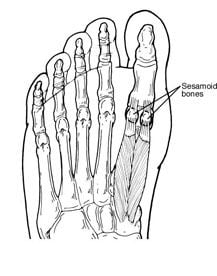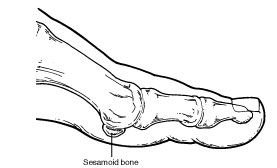What is a Sesamoid?
 A sesamoid is a bone embedded in a tendon. Sesamoids are found in several joints in the body. In the normal foot, the sesamoids are two pea-shaped bones located in the ball of the foot, beneath the big toe joint.
A sesamoid is a bone embedded in a tendon. Sesamoids are found in several joints in the body. In the normal foot, the sesamoids are two pea-shaped bones located in the ball of the foot, beneath the big toe joint.
Acting as a pulley for tendons, the sesamoids help the big toe move normally and provide leverage when the big toe “pushes off” during walking and running. The sesamoids also serve as a weight-bearing surface for the first metatarsal bone (the long bone connected to the big toe), absorbing the weight placed on the ball of the foot when walking, running, and jumping.
Sesamoid injuries can involve the bones, tendons, and/or surrounding tissue in the joint. They are often associated with activities requiring increased pressure on the ball of the foot, such as running, basketball, football, golf, tennis, and ballet. In addition, people with high arches are at risk for developing sesamoid problems. Frequent wearing of high-heeled shoes can also be a contributing factor.
Types of Sesamoid Injuries in the Foot
There are three types of sesamoid injuries in the foot:
- Turf toe. This is an injury of the soft tissue surrounding the big toe joint. It usually occurs when the big toe joint is extended beyond its normal range. Turf toe causes immediate, sharp pain and swelling. It usually affects the entire big toe joint and limits the motion of the toe. Turf toe may result in an injury to the soft tissue attached to the sesamoid or a fracture of the sesamoid. Sometimes a “pop” is felt at the moment of injury.
-
Fracture. A fracture (break) in a sesamoid bone can be either acute or chronic.
-
 An acute fracture is caused by trauma – a direct blow or impact to the bone. An acute sesamoid fracture produces immediate pain and swelling at the site of the break, but usually does not affect the entire big toe joint.
An acute fracture is caused by trauma – a direct blow or impact to the bone. An acute sesamoid fracture produces immediate pain and swelling at the site of the break, but usually does not affect the entire big toe joint. - A chronic fracture is a stress fracture (a hairline break usually caused by repetitive stress or overuse). A chronic sesamoid fracture produces longstanding pain in the ball of the foot beneath the big toe joint. The pain, which tends to come and go, generally is aggravated with activity and relieved with rest.
-
- Sesamoiditis. This is an overuse injury involving chronic inflammation of the sesamoid bones and the tendons involved with those bones. Sesamoiditis is caused by increased pressure to the sesamoids. Often, sesamoiditis is associated with a dull, longstanding pain beneath the big toe joint. The pain comes and goes, usually occurring with certain shoes or certain activities.
Diagnosis
In diagnosing a sesamoid injury, the foot and ankle surgeon will examine the foot, focusing on the big toe joint. The surgeon will press on the big toe, move it up and down, and may assess the patient’s walking and evaluate the wear pattern on the patient’s shoes. X-rays are ordered, and in some cases, advanced imaging studies may be ordered.
Non-Surgical Treatment
Non-surgical treatment for sesamoid injuries of the foot may include one or more of the following options, depending on the type of injury and degree of severity:
- Padding, strapping, or taping. A pad may be placed in the shoe to cushion the inflamed sesamoid area, or the toe may be taped or strapped to relieve that area of tension.
- Immobilization. The foot may be placed in a cast or removable walking cast. Crutches may be used to prevent placing weight on the foot.
- Oral medications. Nonsteroidal anti-inflammatory drugs (NSAIDs), such as ibuprofen, are often helpful in reducing the pain and inflammation.
- Physical therapy. The rehabilitation period following immobilization sometimes includes physical therapy, such as exercises (range-of-motion, strengthening, and conditioning) and ultrasound therapy.
- Steroid injections. In some cases, cortisone is injected in the joint to reduce pain and inflammation.
- Orthotic devices. Custom orthotic devices that fit into the shoe may be prescribed for long-term treatment of sesamoiditis to balance the pressure placed on the ball of the foot.
When is Surgery Needed?
When sesamoid injuries fail to respond to non-surgical treatment, surgery may be required. The foot and ankle surgeon will determine the type of procedure that is best suited to the individual patient.

 An acute fracture is caused by trauma – a direct blow or impact to the bone. An acute sesamoid fracture produces immediate pain and swelling at the site of the break, but usually does not affect the entire big toe joint.
An acute fracture is caused by trauma – a direct blow or impact to the bone. An acute sesamoid fracture produces immediate pain and swelling at the site of the break, but usually does not affect the entire big toe joint.